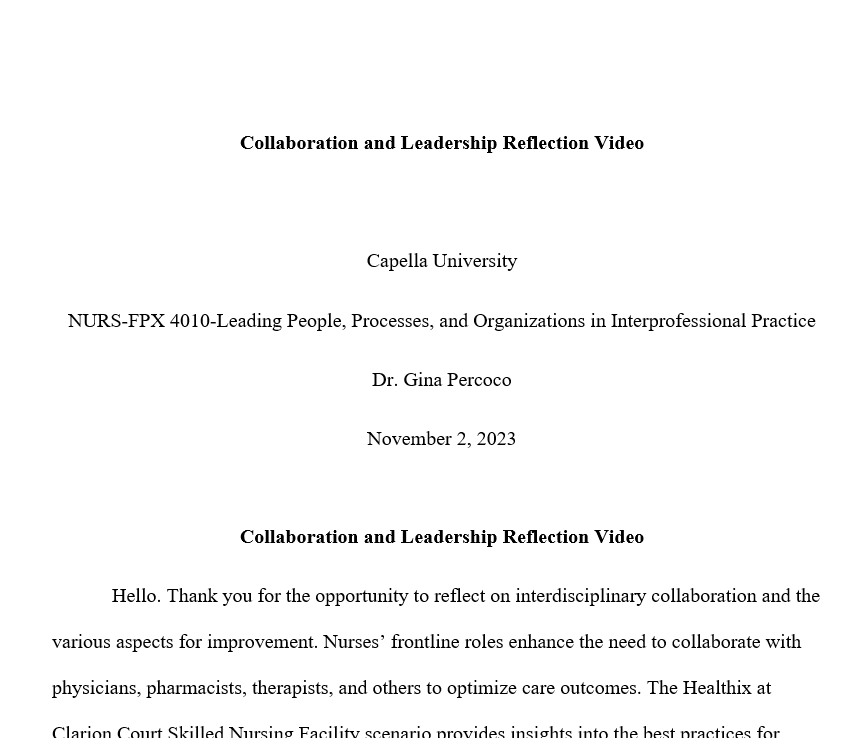Collaboration and Leadership Reflection Video
Capella University
NURS-FPX 4010-Leading People, Processes, and Organizations in Interprofessional Practice
Carolyn Woods
July 21, 2023
Collaboration and Leadership Reflection Video
Introduction
Hello. This presentation focuses on a personal reflection of interdisciplinary collaboration and lessons on the best practices for optimizing outcomes for the Vila Health team. I will address successful and unsuccessful outcomes to highlight the need for evidence-based strategies for improving the quality and safety of patient care. As nurses, we have the frontline obligation to dedicate time and energy toward sharing knowledge, skills, and experiences with clinical and non-clinical staff to improve the safety and quality of patient care.
The goal is to embrace team function skills that increase opportunities to visualize and respond to events in the healthcare environment. Asif et al. (2019) stressed the need for healthcare professionals to embrace values, beliefs, and behaviors that allow them to interact with colleagues, identify risks, and intercept them on time to avoid adverse outcomes.
My Reflection on an Interdisciplinary Collaboration Experience
My experience as a crisis care nurse provided insights into the need for nurses to collaborate with different professionals to improve a patient’s quality of life. The process demonstrated the need for effective communication and positive attitudes and values to enhance responsiveness to a patient’s needs. According to Matusov et al. (2022), being part of a complex care environment reinforces the need for close observation of events associated with collaboration and coordination across the care continuum.
During the outbreak of the COVID-19 pandemic, organizations experienced increased patient traffic. The risks of infection became a challenge, since a section of the workforce, expressed fears about handling patients with COVID-19 complications. The anxiety forced some to consider taking breaks, consequently increasing the number of patients handled by a single nurse. As a nurse in the crisis care unit, it felt overwhelming considering that the team handled patients including the elderly with multiple chronic complications.
(NURS-FPX 4010-Leading People)
In this section, I will discuss how poor collaboration can result in inefficient management of human and financial resources.
With a sharp increase in patient volumes, critical care nurses collaborated with physicians, respiratory therapists, trainees, and critical care fellows to take care of the vast majority of patients. As such, improved communication reinforced the effectiveness of rounding practices in the critical care unit. Successes of the interdisciplinary practices included the ability to save more patients from morbidity and mortality risks through improved sharing of knowledge, skills, and tasks.
Additionally, the team members’ emotional and psychological stability ensured that everyone remained committed to the patient-centered and outcome-based practices. However, it was challenging working in an environment characterized by an increased risk of infections. Nonetheless, a sense of cohesiveness, professional obligation, and purpose, encouraged the team to commit to handling COVID-19 patients and helping them recover fully.
(NURS-FPX 4010-Leading People)
The experience reinforced awareness about the need for robust interdisciplinary collaboration, quality commitment, and cohesion to achieve desired the best outcomes. I observed the need for healthcare professionals to remain resilient during difficult moments. Resilience enhances commitment to monitoring a patient’s progress and sustaining effective rounding practices to optimize care outcomes. Handling elderly patients with COVID-19 symptoms and other health challenges was an excellent opportunity for the team members to develop the mental and emotional capacity to respond to complex scenarios.
(NURS-FPX 4010-Leading People)
This section addresses the best-practice interdisciplinary collaboration strategies to help a team to achieve its goals and work together more effectively
The Villa Health scenario provides insights into the need for effective leadership to guide teams and ensure the successful implementation of new technology. Notably, competent leaders create the right culture characterized by an individual and collective commitment to sharing ideas, knowledge, and skills to improve clinical processes (Reeves et al., 2017). For this reason, the Vila Health scenario reveals the need for leaders to model behaviors, values, and attitudes that align with interprofessional collaboration. NURS-FPX 4010-Leading People
The goal is to encourage the workforce to align interests with the strategic goals of the facility. However, leaders in the organization responded negatively to demands for well-coordinated and collaborative practices. The failure to engage various members of the care team limited individuals from understanding and appreciating the intended changes. Specifically, it was important for leaders to initiate staff education and training, including initiating briefings that make everyone familiar with the relevance of EHRs. A large section of the workforce remained unaware of the proposed changes and their implications on the quality and safety of patient care.
(NURS-FPX 4010-Leading People)
Similarly, the team could not understand the effects of EHRs on workflows and productivity due to an ineffective change management process. In the end, patients became vulnerable to adverse outcomes including risks of severe complications and premature death associated with poor collaboration. The absence of adequate consultations from the initiation to the implementation phase limited Vila Health from benefitting from one of the viable technologies in today’s healthcare system (Reeves et al., 2017). EHRs enable the care team to process clinical data and make informed decisions across the care continuum.
(NURS-FPX 4010-Leading People)
The technology helps nurses reduce medication errors and improve the quality of clinical documentation. In the absence of well-coordinated care, it becomes challenging to visualize the gains provided by EHRs. The problem at Vila Health worsened after the leaders failed to consult the IT team responsible for overseeing a larger part of the implementation process. Resistance from the group made it difficult for the organization to identify gaps in the design and implementation process and timely interventions required to improve the situation.
(NURS-FPX 4010-Leading People)
I will now focus on the best-practice leadership strategies to improve an interdisciplinary team’s ability to achieve its goals
The Vila Health example demonstrates the need for organizations to make meaningful progress through proactive interdisciplinary practices. Notably, the right processes motivate individuals and teams to share ideas, knowledge, and experiences on the issues in the care environment and strategies for enabling the organization to respond to patients’ needs and expectations. Karam et al. (2021) focused on the need for competent leadership to model interdisciplinary behaviors, values, and skills. The right leaders focus more on team efforts due to the need for collective aspirations toward providing patient-centered and outcome-based care across the care continuum.
For instance, the transformational leadership approach would enable Vila Health to motivate employees and leaders to find better ways of improving the quality and safety of patient care (Asift et al., 2019). The transformational leader inspires and motivates the workforce to adopt changes through excellent rapport across the organization. Equally, the leaders work to change the system by encouraging individuals and teams to find experiences that reinforce the commitment to meaningful progress in delivering evidence-based care.
For Vila Health, the leaders failed to acknowledge the need to shift from the status quo. Such limitations create a climate where employees have a lower commitment to the organization. The workforce also shows lower levels of morale, job satisfaction, and performance, consequently increasing error rates and other adverse outcomes.
(NURS-FPX 4010-Leading People)
In conclusion, the Vila Health scenario is an excellent example of leadership incompetency that make it challenging for healthcare providers to make significant progress. Despite leaders at Vila Health, lacking knowledge and experience in effective EHRs implementation failed to seek input from key members of the workforce including the IT and nursing team. As such, leadership changes are necessary to enable the facility to acquire individuals who can model interdisciplinary collaboration practices. The leader appreciates individual and collective contributions and dedicates time and energy to initiating discussions about intended changes and roles of the workforce in promoting successful outcomes.
(NURS-FPX 4010-Leading People)
References
Asif, M., Jameel, A., Hussain, A., Hwang, J., & Sahito, N. (2019). Linking transformational leadership with nurse-assessed adverse patient outcomes and the quality of care: Assessing the role of job satisfaction and structural empowerment. International Journal of Environmental Research and Public Health, 16(13), 1-13. https://www.ncbi.nlm.nih.gov/pmc/articles/PMC6651060/pdf/ijerph-16-02381.pdf
Karam, M., Chouinard, M.C., Poitras, M.E., Couturier, Y., Vedel, I., Grgurevic, N et al. (2021). Nursing care coordination for patients with complex needs in primary healthcare: A scoping review, 21(1), 1-21. https://www.ijic.org/articles/10.5334/ijic.5518/
Matusov, Y., Matthews, A., Rue, M., Sheffield, L., & Pedraza, I. (2022). Perception of interdisciplinary collaboration between ICU nurses and resident physicians during the COVID-19 pandemic. Journal of Interprofessional Education, 27, 1-4. https://www.ncbi.nlm.nih.gov/pmc/articles/PMC8804086/
Reeves, S., Pelone, F., Harrison, R., Goldman, J., & Zwarenstein, M. (2017). Interprofessional collaboration to improve professional practice and healthcare outcomes. Cochrane Database of Systematic Reviews, 6(6), 1-47. https://pubmed.ncbi.nlm.nih.gov/28639262/

